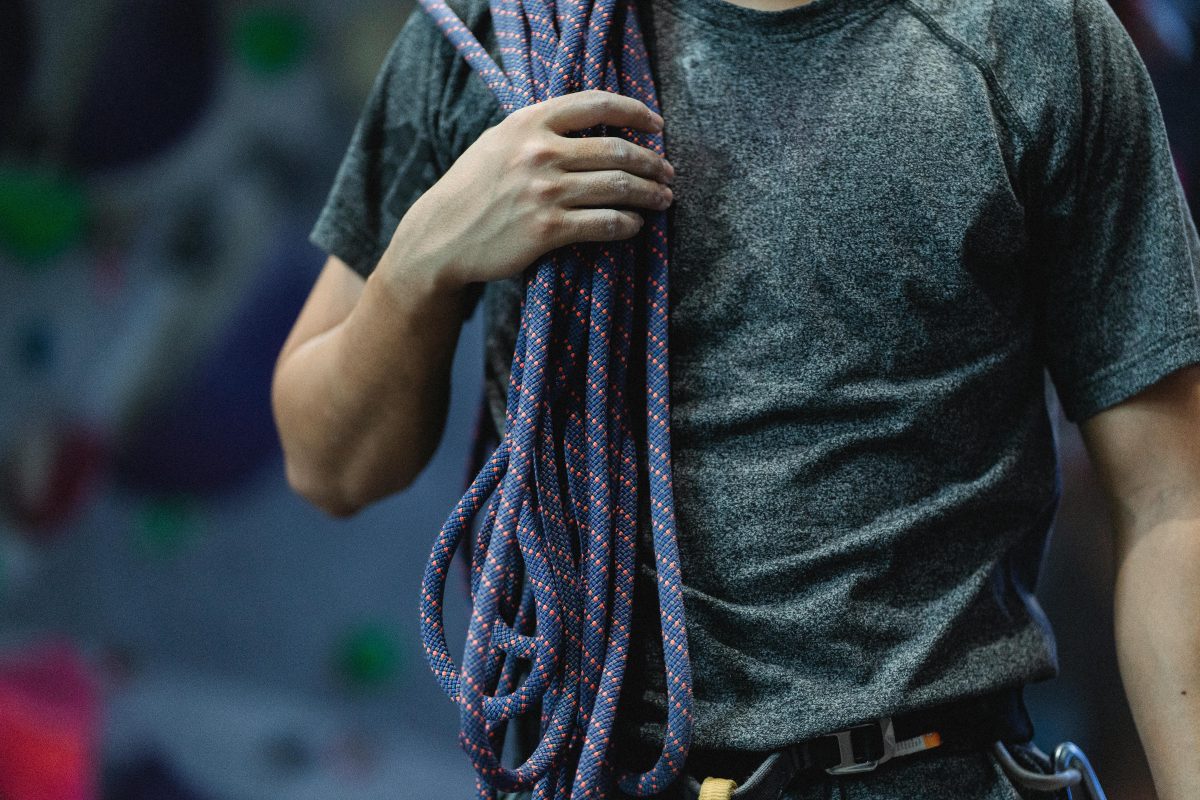Last Updated on: 14th July 2024, 09:31 am
Introduction to Rock Climbing as Exercise

Rock climbing, a sport that challenges both the mind and body, has ascended from its niche origins to become a beloved global fitness regimen. Initially practiced by adventurers seeking to conquer natural rock formations, it has evolved dramatically. Today, it’s not just an outdoor pursuit but a mainstream fitness activity, accessible in gyms and specialized climbing centers worldwide. This transformation is a testament to its effectiveness as a full-body workout, offering a unique blend of strength training, endurance, and flexibility exercises.
The history of rock climbing stretches back over a century, with its roots deeply embedded in the pursuit of mountaineering. What began as a necessary skill for explorers has morphed into a sport in its own right, with disciplines ranging from bouldering to long multi-pitch climbs. Its evolution reflects a growing recognition of the physical and mental benefits it offers, making it a popular choice for those seeking a dynamic and engaging approach to fitness.
As a physical activity, rock climbing stands out for its ability to engage nearly every muscle group. Climbers rely on their arms and legs to propel themselves upward, while their core muscles work overtime to maintain balance and stability. This synergy of movement not only builds muscle but also enhances coordination and mental focus, making rock climbing a holistic exercise option that challenges the body and the mind.
The Anatomy of Rock Climbing

Understanding the Muscles Engaged During Climbing
Rock climbing is not just about reaching the top; it’s a full-body symphony. Each move engages a complex network of muscles:
- Latissimus dorsi, biceps, and forearms: powering your pull-ups.
- Legs, particularly the quadriceps and calves, push you upwards.
- Small stabilizing muscles around your shoulders and hips: crucial for those delicate maneuvers.
The Role of Core Strength in Maintaining Balance and Stability
Imagine your core as the conductor of this symphony, orchestrating balance and stability. A strong core is indispensable, enabling climbers to maintain body positions that defy gravity. It’s not just about the abs; the core encompasses muscles around the trunk and pelvis, all working together to keep you steady on the vertical dance floor.
The Importance of Grip Strength and Upper Body Conditioning
Grip strength is your handshake with the rock. It’s vital, dictating the duration and quality of your climb. This is where upper body conditioning comes into play, transforming your arms and shoulders into powerful engines. Together, they ensure that every grip, no matter how small, is a secure one. Conditioning these muscles can mean the difference between conquering a route and taking an unintended detour back to the ground.
In conclusion, rock climbing is a masterclass in physical fitness, engaging a wide array of muscles, demanding core strength for balance, and relying on grip strength and upper body power. It’s a sport that doesn’t just challenge your body; it transforms it.
Cardiovascular Benefits of Rock Climbing

Elevating Heart Rate for Cardiovascular Health
Rock climbing is a heart-pumping adventure that elevates your heart rate, akin to traditional cardio exercises. The constant movement, from scaling walls to gripping and reaching, ensures your heart works harder, pumping blood more efficiently throughout your body. This cardiovascular workout strengthens the heart muscle, reducing the risk of heart disease and improving overall heart health.
Comparison with Traditional Cardio Exercises
Unlike the repetitive motion of running or cycling, rock climbing offers a dynamic and unpredictable physical challenge. Each climb is a unique puzzle, engaging the body and mind in ways that traditional cardio exercises cannot match. This variety not only keeps the heart rate up but also makes workouts more engaging and less monotonous.
Boosting Endurance and Stamina
Rock climbing demands sustained effort, which in turn, builds endurance and stamina. Climbers learn to manage their energy efficiently, pushing their limits with each ascent. This improved endurance translates to better performance in other sports and daily activities, showcasing rock climbing’s role in a well-rounded fitness regimen.
By integrating rock climbing into your workout routine, you’re not just embarking on an exhilarating journey; you’re also fortifying your heart and building a foundation of endurance that benefits every aspect of your life. Whether you’re a seasoned climber or a newcomer to the sport, the cardiovascular benefits are undeniable, making rock climbing a compelling addition to any fitness plan.
Mental Health and Cognitive Benefits of Rock Climbing

Psychological Advantages: Focus, Problem-Solving, and Stress Relief
Rock climbing is more than a physical challenge; it’s a mental workout. Climbers experience a unique blend of focus and problem-solving as they navigate routes, akin to solving a puzzle with their body and mind. This intense concentration can provide a break from daily stressors, offering a form of moving meditation that clears the mind and relieves stress.
Mindfulness and Mental Health
Engaging in rock climbing can be a practice in mindfulness, as climbers must be fully present to succeed. This presence, or mindfulness, has been linked to improved mental health outcomes, including reduced symptoms of anxiety and depression. The sport encourages climbers to live in the moment, fostering a sense of mental clarity and peace.
Building Confidence and Overcoming Fears
Rock climbing is also a powerful tool for building self-confidence and overcoming fears. With each climb, individuals face their physical and psychological limits, pushing through barriers they once thought insurmountable. The sense of achievement in reaching the top can boost self-esteem and empower climbers to tackle other challenges in life with a newfound confidence.
In conclusion, rock climbing offers profound mental health and cognitive benefits, from enhancing focus and problem-solving skills to serving as a powerful form of stress relief. Its role in promoting mindfulness and mental well-being, alongside its ability to build confidence and overcome fears, makes it an invaluable addition to any fitness regimen. As climbers ascend, they not only strengthen their bodies but also nurture their minds, proving that rock climbing is indeed a holistic exercise.
Flexibility and Injury Prevention in Rock Climbing

Enhancing Flexibility and Range of Motion
Rock climbing is a ballet on the vertical, demanding not just strength but also grace. It naturally promotes flexibility and a full range of motion. As climbers reach, stretch, and contort to navigate routes, their bodies become more pliable. This flexibility is crucial, allowing for smoother movements and reducing the risk of strains.
Preventing Common Climbing Injuries
Injuries can sideline climbers, but proper technique and conditioning are key shields against harm. Tendonitis and pulley injuries in the fingers, along with shoulder and knee issues, are common. To prevent these, climbers must focus on building a foundation of strength, particularly in the muscles that support these areas. Incorporating exercises that mimic climbing movements can fortify the body, making it more resilient.
The Critical Role of Warm-Up and Cool-Down Exercises
Every climb should begin and end on the ground. Warm-up exercises, such as dynamic stretching and light cardiovascular activity, prepare the muscles and joints for the demands of climbing. They increase blood flow and flexibility, reducing the risk of injury. Similarly, cool-down exercises, including static stretching, help to flush out lactic acid and reduce muscle stiffness. These practices are not just routines; they are rituals that honor the body’s need for preparation and recovery.
By integrating these elements into their training, climbers can enhance their performance, prevent injuries, and enjoy a longer, more fulfilling climbing journey. The path to the top is not just about strength or endurance; it’s about moving with intention and respect for one’s body.
Nutrition and Hydration: The Climber’s Edge

Optimizing Performance and Recovery Through Nutrition
Scaling walls and conquering peaks demands more than sheer willpower; it requires fuel. Nutrition is the cornerstone of a climber’s performance and recovery. Carbohydrates provide the quick energy needed for intense bursts of activity, while proteins are essential for muscle repair post-climb. Balancing these nutrients, along with healthy fats, ensures a steady supply of energy and aids in the body’s healing process after a rigorous session.
Hydration Strategies for Peak Climbing Performance
Hydration is just as critical as the climb itself. Dehydration can lead to decreased strength, endurance, and focus, all of which are detrimental when you’re hanging off a cliff. Climbers should aim to drink water regularly before, during, and after their climb, with an emphasis on replacing electrolytes lost through sweat. This can be achieved through:
- Electrolyte-replenishing drinks
- Snacks that naturally contain sodium and potassium
Fueling Your Ascent: Foods and Supplements for Climbers
When it comes to food, climbers need portable, nutrient-dense options such as:
- Nuts, seeds, and energy bars for on-the-go snacking
- Bananas and dried fruits for a quick carbohydrate fix
- Lean jerky or a handful of almonds for a protein boost
For those looking to supplement their diet, omega-3 fatty acids can help reduce inflammation, and vitamin D supplements support bone health, crucial for climbers who may not get enough sun exposure.
Integrating smart nutrition and hydration practices into your climbing routine can elevate your performance, enhance recovery, and ensure that every climb is as exhilarating as the first. With the right fuel, your body will be ready to tackle any challenge the rock presents.
Getting Started with Rock Climbing

Tips for Beginners on How to Get into Rock Climbing
Embarking on your rock climbing journey begins with a step towards understanding the basics. Start by visiting local climbing gyms and talking to experienced climbers. Their insights can guide you on the right path, illuminating the nuances of this exhilarating sport.
The Importance of Professional Instruction and Finding the Right Climbing Gym
Professional instruction is not just beneficial; it’s essential. A certified instructor can teach you proper techniques, ensuring your safety and boosting your confidence. Moreover, finding the right climbing gym, one that caters to beginners and offers a variety of routes, is crucial. It becomes a sanctuary where you can practice, learn, and grow.
Safety Equipment and How to Use It Properly
Safety cannot be overstated in rock climbing. Essential gear includes:
- Helmet
- Harness
- Climbing shoes
- Belay device
Each piece serves a purpose, from protecting your head to securing you on the rope. Learning to use this equipment correctly is a fundamental step in your climbing education.
Setting Realistic Goals and Tracking Progress in Rock Climbing
Setting realistic goals and tracking your progress is vital. Begin with simple climbs, gradually increasing in difficulty as your skills improve. Celebrate each achievement, no matter how small, and use setbacks as learning opportunities. This mindset not only fosters growth but also keeps the journey enjoyable.
Rock climbing is more than just a physical challenge; it’s a pathway to discovering your strengths and pushing beyond limits. With the right approach, equipment, and guidance, anyone can embark on this thrilling adventure. Remember, the climb to the top starts with a single step. Let your journey begin today.
In Closing
Rock climbing transforms body and mind. It’s an adventure in resilience and joy. Through the interplay of physical challenge and mental engagement, climbers experience a journey of growth, discovering strength and flexibility not just in their muscles, but in their resolve. This article has navigated the multifaceted benefits of rock climbing, from its full-body workout to its mental health advantages, underscoring the sport’s role in fostering a balanced, healthy lifestyle. Let the climb inspire you to reach new heights, embracing the journey as much as the destination.
Rock Climbing as a Full-Body Workout FAQs
Yes, rock climbing can be an effective activity for weight loss. It is a high-intensity workout that burns a significant amount of calories, especially during long climbs or more intense bouldering sessions. Alongside a balanced diet, regular climbing can contribute to a healthy weight loss regime.
No, you do not need to be in good shape to start rock climbing. Climbers of all fitness levels can begin with routes that match their current ability and gradually progress to more challenging climbs. Starting rock climbing can actually be a motivating way to get in shape, as it offers tangible goals and a fun, supportive community.
To prevent injuries while rock climbing, proper warm-up, and cool-down routines are essential, along with practicing good technique and listening to your body’s limits. Focusing on building a strong foundation of core and upper body strength can help support your climbs and reduce strain. Additionally, learning proper falling techniques and using appropriate safety gear are crucial for minimizing the risk of injury.
Rock climbing engages a wider range of muscles more dynamically than most standard gym workouts. While gym routines often target specific muscle groups, climbing requires the use of almost every muscle in the body to pull, push, and stabilize movements on the wall. This holistic engagement results in a more balanced muscle development and higher functional strength.
Climbing two to three times a week can lead to noticeable fitness improvements. This frequency allows your body to recover and adapt, gradually increasing muscle strength and endurance. Consistency is key to improving technique and climbing skills, which directly contribute to fitness levels.
While having a climbing partner is essential for certain types of climbing, such as traditional or sport climbing, you can climb solo when bouldering or using auto-belay systems in climbing gyms. A partner provides safety through belaying and can offer motivation and advice. However, bouldering and auto-belays allow for flexibility in schedule and the opportunity to focus on personal progress.
Yes, rock climbing is an excellent full-body workout. It engages multiple muscle groups simultaneously, including the arms, legs, back, and core, providing a balanced strength and endurance challenge. The sport also improves flexibility and mental strength, as climbers navigate routes.
Rock climbing offers significant mental benefits, including stress reduction, improved focus, and increased confidence. The problem-solving aspect of navigating routes enhances cognitive functions, while the physical exertion releases endorphins, contributing to a sense of well-being. The sport also fosters a sense of community and support, which can be beneficial for mental health.
To start rock climbing, you will need a pair of climbing shoes, a harness, a chalk bag, and access to a climbing gym or outdoor climbing area. Climbing shoes improve grip on the wall, the harness is necessary for roped climbing, and chalk helps keep your hands dry for better friction. As you progress, you may also consider purchasing a helmet, especially for outdoor climbing, to protect against falls and debris.
Activities that build endurance, flexibility, and core strength, such as yoga, swimming, and cycling, are beneficial for rock climbers. These activities complement climbing by improving overall fitness, reducing the risk of injury, and enhancing recovery. Focusing on core stability and flexibility can particularly help in achieving better climbing technique and performance.
Orlando is a all round athlete from Australia, now resident in Germany. His sports of passion of American Football(Offensive line), weight training and indoor rock climbing where he uses his 195cm wing span to his advantage.



